The Best Florida Shade Plants – Pictures and Identification Guide

Knowing the best shade plants for Florida is vital for growing a beautiful garden landscape. Florida’s long, hot summer days and humid climate mean that many plants struggle in direct sunshine. Also, not all flowering ornamentals, perennials, bushes, shrubs, and ground cover plants thrive in shaded conditions. Therefore, finding the best Florida shade plants can help transform your front or backyard.
Plants that thrive in the shade should ideally grow well in fewer than four hours of direct sunlight daily. Many species of shade-loving flowering shrubs like azaleas and hydrangeas add plenty of colorful flowers and evergreen foliage. Additionally, low-growing plants for the shade like periwinkle and caladiums are ideal for planting along shrub borders.
What are the best shade plants for growing in Florida’s hot and humid climate? This article lists the top flowering plants and shrubs that thrive in the Sunshine State.
What are Shade Plants?
Shade plants can thrive in gardens that get limited direct sunlight during the day. Shade-loving plants have few light requirements and grow as understory plants beside a shaded wall, in a north-facing garden, or in constant shadows. Some Florida plants grow best in dappled shade, and some plants get by on ambient light.
Of course, all plants need some level of light to grow and photosynthesize. Here are descriptions of light conditions for shade-tolerant plants and shrubs:
- Heavy shade—Plants perform well even when they get almost no direct sunlight.
- Full shade—Ornamentals, evergreens, and perennials that grow well and bloom when only receiving one hour of sunlight daily. These plants are usually permanently in the shadows of buildings, large trees, or shrubs.
- Partial shade—These shade-tolerant plants perform well when they get around two hours of sunlight daily.
- Light shade—Plants thrive in three to five hours of sunlight, especially the morning sun.
Growing Zones for Shade Plants in Florida
Before choosing which shade plants to grow in a Florida garden, it’s crucial to ensure the shrub, perennial plant, evergreen bush, or flowering ornamental is in the correct growing zone. Some plants are intolerant of the cold and will struggle in Northern Florida. However, plants for USDA zone 9 will wither in the heat and humidity of southern Florida and the Florida Keys.
Here is an explanation of Florida’s growing zones:
- Florida Zone 8—The northwest of Florida in the panhandle. Cities in zone 8 include Pensacola, Tallahassee, and Panama City. The average minimum winter temperature is 20°F (-6.6°C).
- Florida Zone 9—This is mainly the central part of Florida from the east to the west coast. Cities in zone 9 include Orlando, Jacksonville, and Tampa. The average minimum winter temperature is 25°F (-3.8°C).
- Florida Zone 10—The area of Florida to the south of Lake Okeechobee. Cities in zone 10 include Fort Lauderdale, Cape Coral, and Naples. The average minimum winter temperature is 30°F to 35°F (-1.1°C – 1.7°C).
- Florida Zone 11—This is the southernmost tip of Florida that includes the Florida Keys and some parts of the mainland on the eastern coast.
It’s good to note that depending on climatic conditions, elevation, and proximity to the coast, some plants may perform better than others where two zones meet.
How to Choose Shade Plants in Florida
Florida shade plants with colorful blooms and leaves offer color and beauty to your landscape. When choosing suitable plants for growing in shaded areas, you’ll need to consider a few factors — the most crucial of which is sun tolerance. Some shade plants need a few hours of sunlight, whereas others prefer constant shade.
Other factors influencing shade-tolerant plants in Florida include cold-hardiness zone, soil type, and watering requirements. In addition, it’s also vital to think about the shrub’s size, pruning, and if the plant flowers or not.
Shade Plants in Florida (with Pictures) — Identification
Let’s look at shade plants suitable for growing in zones 8 through 11. These shade-loving plants are divided into flowering shade plants, low-growing shade plants, tall shade plants, and shrubby shade plants. All are suitable for growing in Florida’s unique climate.
Flowering Shade Plants For Florida
Bolivian Sunset (Gloxinia sylvatica)
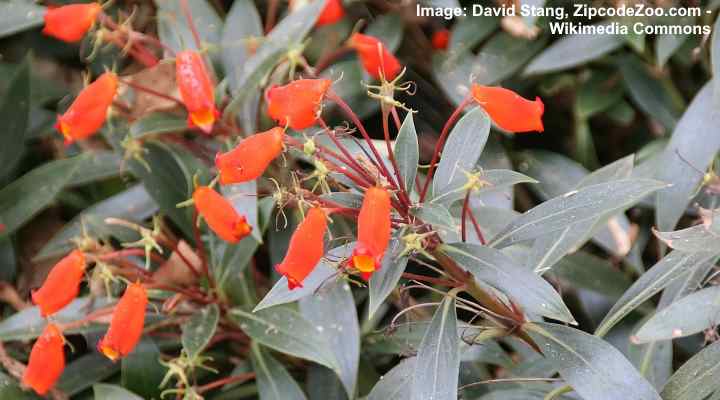
Bolivian sunset is a flowering shade plant for Florida gardens. It grows well in filtered sun or dappled shade
Bolivian sunset is an attractive shade tolerant flowering shrub with orange-red tubular flowers. The beautiful leafy shrub has shiny dark green lanceolate leaves growing on eye-catching red stems. This winter-flowering plant grows up to 2 ft. (60 cm) tall and wide and thrives in warm, humid conditions. It is ideal for planting in shaded Florida gardens.
The Bolivian sunset plant is relatively low-growing and has many landscape uses in Florida. The Bolivian sunset plant is ideal for adding color to rock gardens or shaded borders and mixed beds. It also performs well with other Florida shade plants.
Size: 24” (60 cm) tall and wide.
Sun exposure: Partial shade
USDA growing zones: 9 to 11
Pinwheel Jasmine (Gardenia jasminoides ‘Pinwheel’)
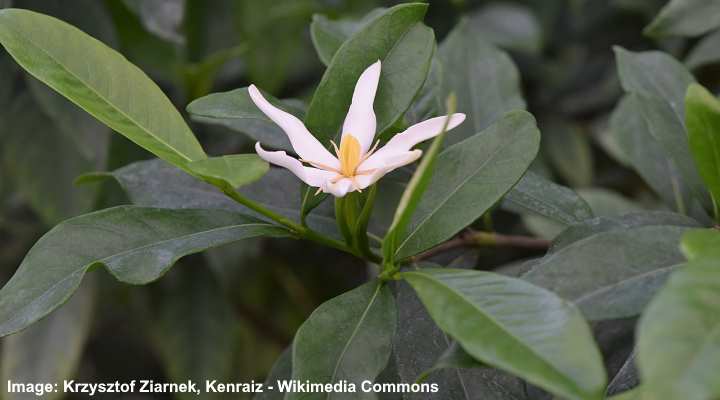
Pinwheel jasmine is an attractive flowering shrub for partial shade that is also suitable for south Florida
Pinwheel Jasmine is a cold-hardy, shade tolerant, flowering plant thriving as far south as the Florida Keys. The beautiful evergreen shrub is adorned with glossy green lance-shaped leaves and white-petalled flowers that give off an intense fragrance. Also called pinwheel cape jasmine, the bushy shrub grows up to 4 ft. (1.2 m) tall and wide.
Pinwheel jasmine is the ideal all-rounder for Florida gardens. The lustrous shrub performs just as well in full sun as partial shade. In addition, the evergreen shrubs are suitable for a flowering hedgerow, container plant, or back of the bed shrub.
Size: 4 ft. (1.2) tall and wide
Sun exposure: Partial sun
USDA growing zones: 6 to 11
African Iris (Dietes vegeta or Dietes iridioides)
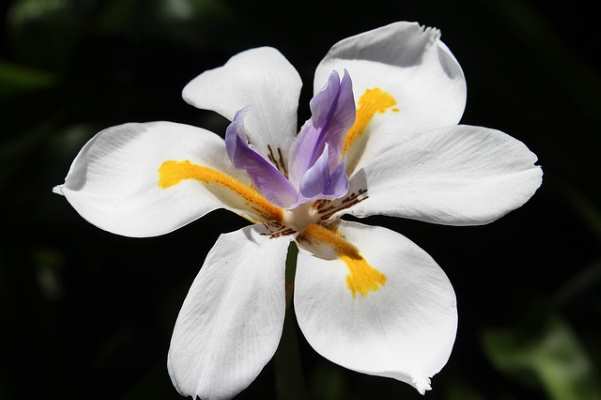
You can grow potted African iris on a partial shaded porch or as a foundation plant for dappled shade
African iris is a beautiful flowering plant for Florida gardens. It has lily-like flowers consisting of white rounded petals that have shades of purple and yellow. Also called fortnight lily or morea iris, the shade-tolerant clumping plant has long, slender pointed leaves growing up to 2 ft. (60 cm) tall.
African iris plants tolerate damp, soggy soil and can withstand occasional drought. The long, narrow grass-like blades, white flowers, and delightful fragrances are ideal for borders or foundation plantings in Florida gardens.
Size: 24” (60 cm) tall and wide
Sun exposure: Full sun to partial shade
USDA growing zones: 9 to 11
Begonias
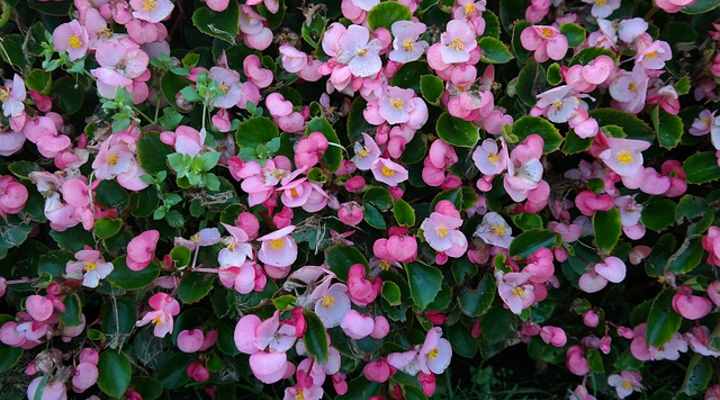
Wax begonia (in the picture) is one of the best colorful flowers for partial shade or dappled sunlight
Three types of begonia plants are suitable for Florida landscapes — wax begonias, cane begonias, and rhizomatous begonias. Flowering begonias perform best in filtered sunlight or partial shade. The attractive plants are famous for their colorful leaves and showy clusters of orange, white, red, and pink flowers.
Begonias are suitable for growing outdoors in all regions of Florida. However, some varieties of begonias are only ideal for zones 10 and 11. The beautiful bushy flowering plants will brighten up any shaded area of your garden. What’s more — they are incredibly easy to care for.
Size: Up to 24” (60 cm) tall and wide
Sun exposure: Partial shade
USDA growing zones: 9 to 11
Bromeliads
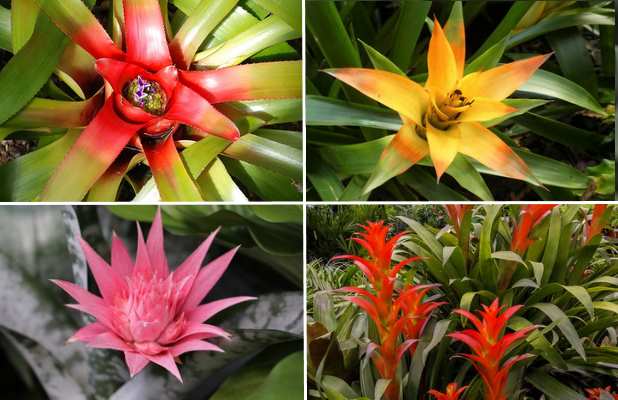
Bromeliads are tropical shade plants that add beautiful color to south Florida landscaped gardens
Bromeliads are shade-loving Florida tropical plants that don’t need much sunlight and thrive in frost-free regions of Florida. The eye-catching colorful plants have thick leaves growing in a distinctive rosette form. The leaves range in color from shades of green and gold or deep red. In addition, many bromeliads have variegated or multi-colored leaves.
An unusual feature of bromeliads is their showy flowers on a long erect stem that emerges from the plant’s center. The rosette flowers usually consist of spiked petals or bracts with arching tips. Bromeliad flowers can be bright red, vibrant pink, golden yellow, and various shades of purple.
Size: From 1” to 36” (2.5 – 90 cm)
Sun exposure: Deep shade (however, check the individual plant for light tolerance)
USDA growing zones: 10 and 11
Low Growing Shade Plants For Florida
Periwinkle (Vinca)

The trailing nature of periwinkle makes it ideal as a ground cover in Florida landscaped gardens
Periwinkle plants are beautiful flowering plants that thrive in partial to deep shade in Florida gardens. The perennial spreading plants are ideal for full-shade ground cover in Florida gardens. The low-growing plants typically have purple flowers, but they also bloom in white, blue, red, and pink shades. Expect periwinkle plants to grow between 4” and 24” (10 – 60 cm) in Florida gardens.
Periwinkle plants are perfect for growing as ground cover, underplanting shrubs, or on slopes. Their glossy dark green leaves, star-shaped purple flowers, and tolerance of full shade make them ideal for challenging landscape conditions.
Size: 4” to 24” (10 – 60 cm)
Sun exposure: Full sun to full shade
USDA growing zones: 4 to 9, although some periwinkle plants are suitable for zone 10
Peace Lily (Spathiphyllum)
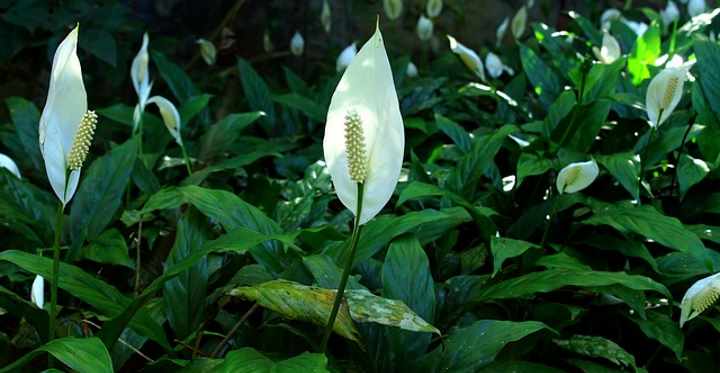
Grow peace lilies in a shady locations with moist soil in south Florida
Peace lilies are evergreen flowering deep shade plants for the southern coast of Florida. The herbaceous perennial peace lily plants are known for their brilliant white spathe flowers and glossy green lanceolate leaves. Peace lilies grow in the garden in USDA zones 11 and 12, so they will only be suitable for growing in southern Florida.
Although they are called lilies, peace lilies are not true lilies. The flowering plants grow in temperatures between 68°F and 85°F (20°C to 30°C) and a minimum of 58°F (10°C) at night. The shade-loving Florida plants grow 1 to 6 ft. (0.3 – 1.8 m) tall.
Peace lilies are on the list of indoor plants that don’t need sunlight.
Size: Up to 6 ft. (1.8 m) tall and 5 ft. (1.5 m) wide
Sun exposure: Partial shade to deep shade
USDA growing zones: 11 and 12
Caladiums
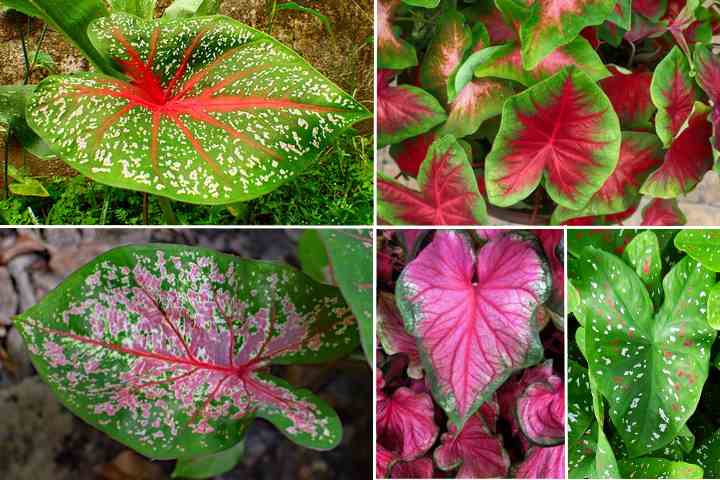
Caladiums are low light tropical plants with colorful leaves
Caladium is a group of low-growing plants with colorful leaves that thrive in shaded, humid Florida gardens. Most caladium plants are suited for full shade growing outdoors. Also called angel wings, caladiums are known for their colorful green, pink, red, and white heart-shaped leaves. When growing in shaded conditions, the colors of caladium leaves are more vibrant.
Caladiums grow between 6” and 24” (15 – 60 cm) tall, depending on the cultivar. Although grown for their colorful foliage, caladiums are flowering plants that produce a single flower similar to peace lilies.
Related reading: How to care for caladiums.
Size: Up to 24” (60 cm) tall.
Sun exposure: Partial shade to full shade
USDA growing zones: 10 to 12
Asiatic Jasmine (Trachelospermum asiaticum)
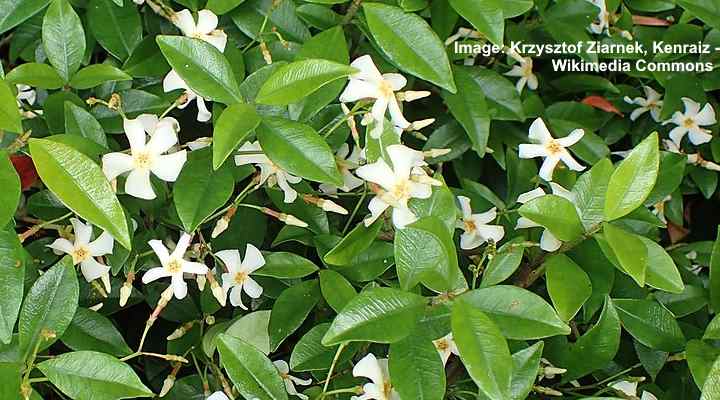
Asiatic jasmine is a low maintenance and easy care flowering plant for partial shade
Asiatic jasmine is an evergreen, low-growing flowering plant that thrives in hot, humid conditions. The low-maintenance ground cover plant with its glossy green lanceolate leaves produces dainty jasmine-like, pinwheel white flowers. Asiatic jasmine grows up to 18” (45 cm) tall and 36” (90 cm) wide.
Planting Asiatic jasmine in Florida landscapes is common where turfgrass won’t grow. The spreading evergreen plant thrives with little care and doesn’t tolerate too much sun. You can also successfully grow Asiatic jasmines in coastal regions of Florida because it is tolerant of salty air.
Size: 6” to 18” (15 – 45 cm) tall and 36” (90 cm) wide
Sun exposure: Partial shade
USDA growing zones: 7 to 11
Variegated Ginger (Alpinia zerumbet ‘Variegata’)

Variegated ginger is an ornamental ginger plant that tolerates partial shade and can be grown outdoors in south Florida
Variegated ginger is an impressive shade-friendly plant for Florida landscapes. The leafy, clumping plant is recognized by its yellow and green variegated lance-shaped leaves and clusters of fragrant bell-shaped flowers. The spectacular low-growing tropical shade plant grows 3 to 6 ft. (1 – 2 m) tall and up to 8 ft. (2.4 m) wide.
Variegated ginger grows best in southern Florida in zones 10 and 11. If you want to grow it outdoors in USDA zones 8 and 9, it’s best to plant it in a container and overwinter it indoors. Landscape uses for variegated ginger include growing it as a specimen bush, front of house shrub, backdrop for smaller plants, or around a palm tree in Florida.
Size: 3 to 6 ft. (1 – 2 m) tall and 8 ft. (2.4 m) wide
Sun exposure: Full sun to partial shade
USDA growing zones: 8 to 10
Tall Shade Plants For Florida
Princess Flower (Tibouchina urvilleana)
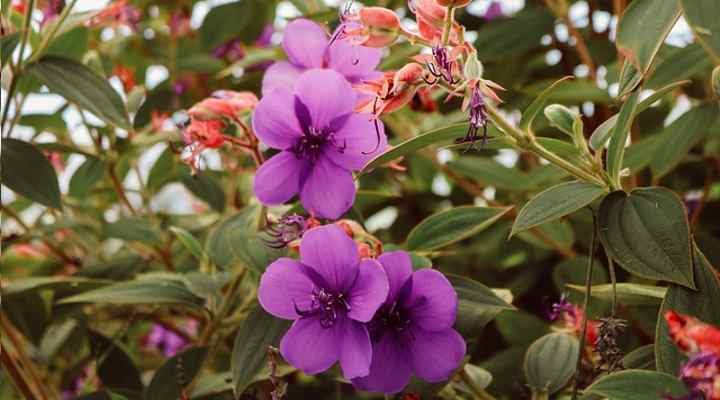
Princess flower is also called glory bush and is a tall flowering plant for partial shade
Princess flower is an evergreen tropical shrub that thrives in full sun to partial shade. The tall flowering plant grows 6 to 8 ft. (1.8 – 2.4 m) in warm, subtropical climates. The beautiful shrub is identified by its showy purple flowers, large ovate leaves, and drought tolerance.
Size: 6 to 8 ft. (1.8 – 2.4 m)
Sun exposure: Full sun to partial shade (two to six hours daily)
USDA growing zones: 9 – 11
Firespike (Odontonema cuspidatum)

Firespike is a flowering bush in Florida that tolerates partial shade
Firespike is a leafy shrub with tall clusters of brightly-colored red tubular flowers. Firespike thrives throughout Florida and grows between 4 to 6 ft. (1.2 – 1.8 m) tall. The attractive feature of the clumping herbaceous plant is its red flower spikes that contrast with the beautiful lanceolate green leaves.
Size: 4 and 6 ft. (1.2 – 1.8 m) tall and 2 to 3 ft. (0.6 – 1 m) wide
Sun exposure: Partial sun or partial shade
USDA growing zones: 8 to 11
Shrubby Shade Plants For Florida
Jacobinia (Justicia carnea)
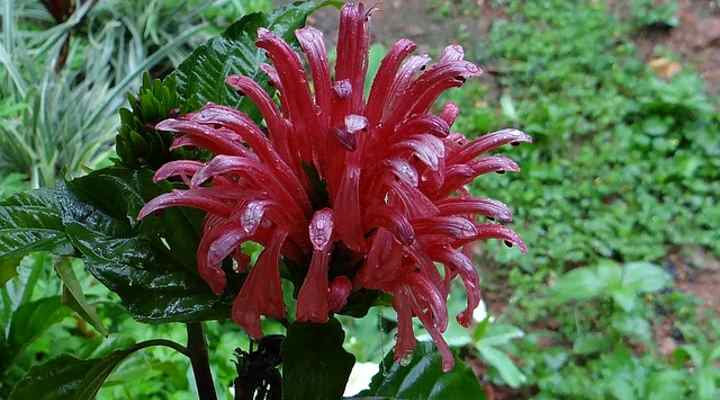
Jacobinia is a blooming shade plant with colorful flowers
Jacobinia is an upright growing shrub with fragrant clusters of red, yellow, purple, or white flowers. The evergreen flowering shrub thrives throughout Florida, adding color to garden landscapes. Landscape uses for jacobinia are flowering evergreen hedges, container plants, or flowering shrubs in shade gardens.
Size: 3 to 6 ft. (1 – 1.8 m) tall and up to 3 ft. (1 m) wide
Sun exposure: Partial to full shade
USDA growing zones: 9 to 11
Croton
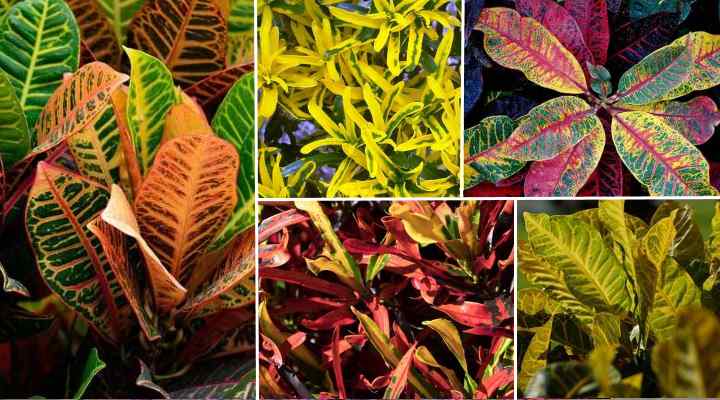
Croton plants grow in partial shade and include many cultivars with beautiful colorful foliage
Croton plants are subtropical colorful foliage shade plants that thrive in Central and South Florida. The beautiful shrubby plants have thick, leathery leaves in green, red, orange, and yellow shades. The large shade-loving shrubs can grow up to 10 ft. (3 m) tall; however, there are also dwarf varieties suitable for compact gardens and containers.
Related reading: How to care for croton plants.
Size: 2 to 10 ft. (0.6 to 3 m) tall depending on the cultivar
Sun exposure: Light shade to partial shade
USDA growing zones: 9 to 11
Oakleaf Hydrangea
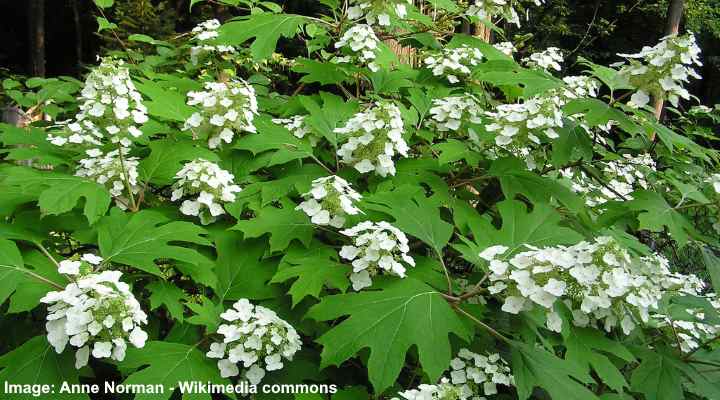
Oakleaf hydrangea is a flowering shrub that can grow in Florida in partial shaded locations
Oakleaf hydrangea is one of the best shade shrubs for Florida gardens. The deciduous large shade-loving shrub is identified by its colorful bronze or purple fall foliage and large clusters of white, conical flowers. Although the oakleaf hydrangea usually thrives in the sun, it performs best in Florida in partial to full shade.
Related reading: How to care for hydrangea plants.
Size: 6 to 8 ft. (1.6 – 2.4 m) tall and wide
Sun exposure: Partial shade
USDA growing zones: 5 to 9
Dwarf Azalea

Dwarf azalea shrubs add a colorful touch to partial shaded Florida gardens
Dwarf azalea shrubs are ideal flowering bushy plants for gardens throughout Florida. The evergreen shrubs bloom between February and April and then occasionally through the year. Dwarf azaleas are known for their showy trumpet-like pink, red, or white flowers with protruding stamens. There are many azalea cultivars and hybrids to choose from for all areas of Florida.
Although Azaleas may become leggy in full shade, they will still produce showy flowers throughout the summer and warm winters.
Size: 4 to 8 ft. (1.2 – 3.4 m) tall and wide
Sun exposure: Full sun to partial shade
USDA growing zones: 6 to 10
Related articles:
